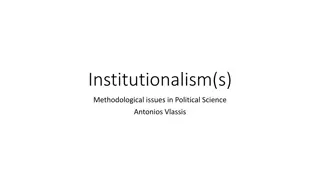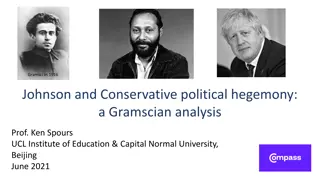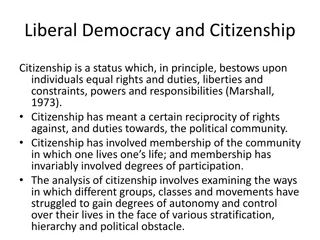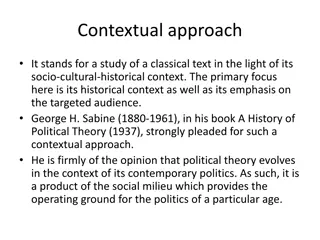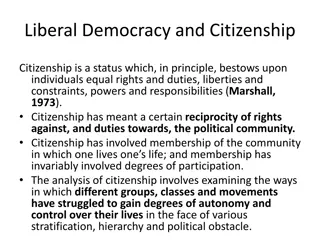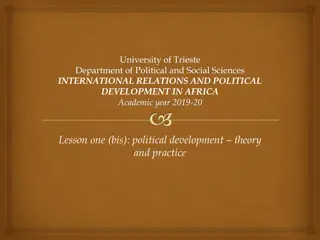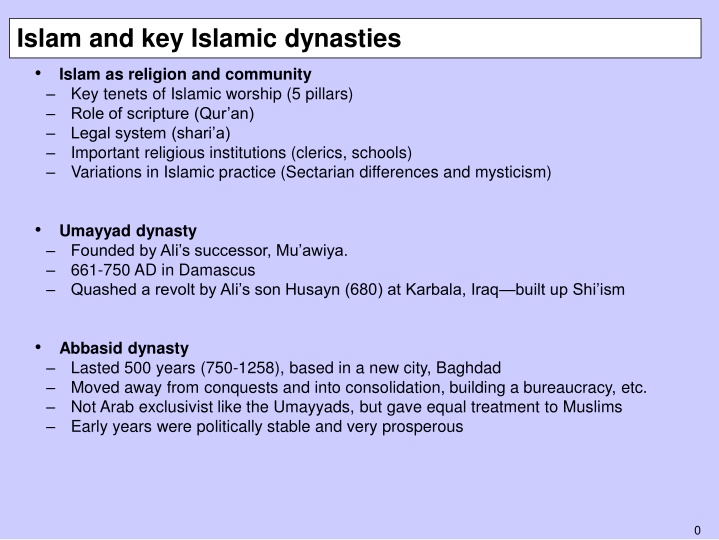
Islamic Dynasties and Empires in the Middle East: A Historical Overview
Explore the rich history of Islamic dynasties and empires in the Middle East, from the Umayyad and Abbasid dynasties to the rise of the Mughals, Ottoman Empire, and Safavids. Discover key events, structures, and challenges faced by these influential entities over centuries.
Download Presentation

Please find below an Image/Link to download the presentation.
The content on the website is provided AS IS for your information and personal use only. It may not be sold, licensed, or shared on other websites without obtaining consent from the author. If you encounter any issues during the download, it is possible that the publisher has removed the file from their server.
You are allowed to download the files provided on this website for personal or commercial use, subject to the condition that they are used lawfully. All files are the property of their respective owners.
The content on the website is provided AS IS for your information and personal use only. It may not be sold, licensed, or shared on other websites without obtaining consent from the author.
E N D
Presentation Transcript
Islam and key Islamic dynasties Islam as religion and community Key tenets of Islamic worship (5 pillars) Role of scripture (Qur an) Legal system (shari a) Important religious institutions (clerics, schools) Variations in Islamic practice (Sectarian differences and mysticism) Umayyad dynasty Founded by Ali s successor, Mu awiya. 661-750 AD in Damascus Quashed a revolt by Ali s son Husayn (680) at Karbala, Iraq built up Shi ism Abbasid dynasty Lasted 500 years (750-1258), based in a new city, Baghdad Moved away from conquests and into consolidation, building a bureaucracy, etc. Not Arab exclusivist like the Umayyads, but gave equal treatment to Muslims Early years were politically stable and very prosperous 0
The Middle East in the Middle Ages Fatimids Founded by Shi a missionaries in North Africa Seljuks Turkish tribes moving Westward Took Iran, and then took control of Baghdad (1055) Crusades 4 Latin kingdoms established in the Eastern Mediterranean 11th and 12th centuries; lasted about 200 years Almoravids and Almohads in Morocco Based in Marrakech from about 1000-1300 AD Expanded over much of North Africa The fury of the Mongols Ravaged Eastern Islamic civilization in the 13th century Sacked Baghdad (1258) Sacked Iran, Damascus (around 1400) 1
The Rise of Middle Eastern Empires Mughals Based in Northern India Safavids Based in Persia from 1500s-1736 Historical development Structure Decline Ottomans Based in Anatolia from the 15th century up to WWI Historical development Structure Administration of Arab regions Why did the Ottoman Empire endure so successfully? Saadians and Alawites Based in present day Morocco and southward Alawites emerged in the 1600s and still rule Morocco 2
Pressures for reform European encroachments on the Ottoman Empire Economic capitulations (starting in 1536) allowed European merchants the right of free trade in Ottoman ports and gave merchants European legal jurisdiction European revolts Russian expansion Balance of power struggles over the Ottoman Empire (Britain/France vs. Russia) Extension of European capital; accumulation of debt to European powers Dismantlement of Ottoman European territory at the Congress of Berlin 1878 Internal Ottoman challenges Loss of control over the Janissary corps Nepotism and incompetent leadership Increasing autonomy in the reaches of the empire Decline in revenue generation (siphoned off by other rulers) Began to fall behind technologically 3
Attempts at reform Muhammad Ali s Egypt (1805-1848): essentially independent from Istanbul Reaction to a French invasion of Egypt in 1798 Led a state-sponsored Europeanization program; imperial expansion; industrialization Wanted independence from the Ottomans Centralized authority, based at the top Ottoman attempts at reform Bring in European military advisors Create new army corps (nizam-i jedid), which alienated the janissaries Open embassies in Europe Attempts to centralize the state Tanzimat reforms (1839-1876): led by Europeanized Ottoman bureaucrats 4
Political legacies Centralized states Iran, Turkey, Egypt, Morocco Amazing states with strong administrative reach Imperial cities Damascus, Baghdad, Cairo, Marrakech, Fez, Isfahan, Istanbul, Mecca Contested zones Iraq (Sunni/Shi a) Parts of the levant Uninstitutionalized areas Arabian peninsula Parts of North Africa Ottoman administrative legacies Use of religious legitimacy (caliph) Extensive bureaucracies Variation in Ottoman incorporation Reform as competition with Europe Dual institutions: European and traditional Loss of power as European power rises 5
The colonial encounter Early colonial impact Context of a rush to colonize Africa and Asia by competing Western European states French landed early in Algeria in 1830; Tunisia (1881) and Morocco (1912) would be incorporated to a lesser degree later Britain annexed Aden (1839), signed treaties with Persian Gulf sheikhdoms and took over foreign policy for Bahrain (1880), Muscat (1891), Kuwait (1899) British intervention in Egypt to resolve Egyptian debt crisis and control the Suez Continued pressure by Russia on Ottoman territory as Russia sought to expand French occupation of Algeria French landed at Algiers in 1830 to punish the military ruler of Algiers Revolt of Abdul Qader against Ottomans & French in the in the interior: 1830s-1848 100,000 European settlers by 1845 native population was dying of war and plague Revolt in the Kabyle region in 1871 British occupation of Egypt Until WWI the relationship between Britain and Egypt was essentially a protectorate Led by Lord Cromer 1883-1907 who built Egypt s economic system Parallel forms of government traditional Ottoman civil service with little power compared to British colonial officials and advisors Khedive Tawfiq (accommodative) and his son Abbas II (early nationalist) 6
Other colonial efforts Uprising in the Sudan Conquered in the 19th century by Muhammad Ali and administered by Egyptians The Mahdi led a rebellion against Egyptian occupation from 1881-1898 Britain was nervous about the French taking the Sudan in the scramble for Africa, and took control in 1898 Tunisia/Morocco Spiraling debt to Europeans in Tunisia led to foreign powers taking over Tunisia s finances in 1868 Tunisian protectorate, with dual government (Ottoman legacy + colonial) Morocco tried to balance between French and British influence Europeans settled in trading cities (Tangier, Casablanca) French protectorate over Morocco established late in the game (1912) Libya Italians invaded, encouraged by the Congress of Berlin (1878) Had originally bought large tracts of land, but due to competition from the Germans, they invaded; both Turkish and Sanusi resistance initially failed 7
Middle Eastern responses to colonial intrusion How did the Middle East respond to these colonial intrusions? Last strong Ottoman Sultan (Abdul Hamid II 1876-1909) tried to move the Ottoman Empire back to focus on its Islamic identity (Osmanlilik) Renewed focus on the broader Islamic ummah Rural Islamic doctrinal movements grew: Wahhabis Sanusi order Mahdiyya Key Islamic thinkers interpreted what was going on: Al-Afghani: Islam had fallen into decadence and stagnation; push for pious and uncorrupted leaders Muhammed Abduh: salafiyya movement; return to the ancestral model for piety and Islamic community, but balanced with human reason Arabs as the true stewards of Islam 8
Early 20th century revolts and the end of the Ottomans Iran Had comparatively little contact with the West during the 19th century Chaotic period in the 18th century after the fall of the Safavids The Qajar dynasty that emerged never had strong central control over the territory Very independent Shi a religious establishment Qajar monarchs moved the capital from Isfahan to Tehran but had little legitimacy and a small army to maintain control Less affected by European pressure and initiated European style reforms late British secured economic capitulations (1857-) Tobacco protest (1891) By 1907, the British and Russians agreed a division of influence over Iran Ottoman Empire Increasing focus on building transportation networks and school systems Increasing focus on building military capabilities and ties with Germany Tight control over any form of political activity or criticism Armenian nationalist revolt (1890s) and harsh suppression Nationalist revolt in Crete (1897) that led to declaration of war by Greece Young Turk revolt 9
Key lecture termsSeptember 19 Byzantine Empire Umayyad Dynasty Sasanian Empire Abbasid Dynasty Muhammad Seljuks Qur an Crusades Mecca Almoravids and Almohads Ummah Mongols Caliphate Mamluks Ali Safavid Empire Sunni Ottoman Empire Shi a Eastern Question Shari a Great Game Sufism Capitulations 10
Key lecture termsSeptember 21 Defensive developmentalism Qajar dynasty Tax farming Ulema Tanzimat Tobacco Protest (1891) Janissaries D Arcy concession Muhammad (Mehmet) Ali Mahdi of Sudan Urabi revolt (1879-82) Wahhabi movement Abdul Qader Sanusi brotherhood Pied Noir Salafiyya movement Khedive Young Turks Congress of Berlin Mount Lebanon 11




